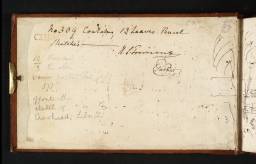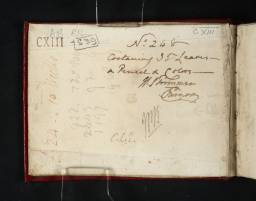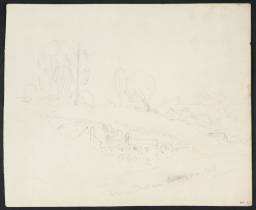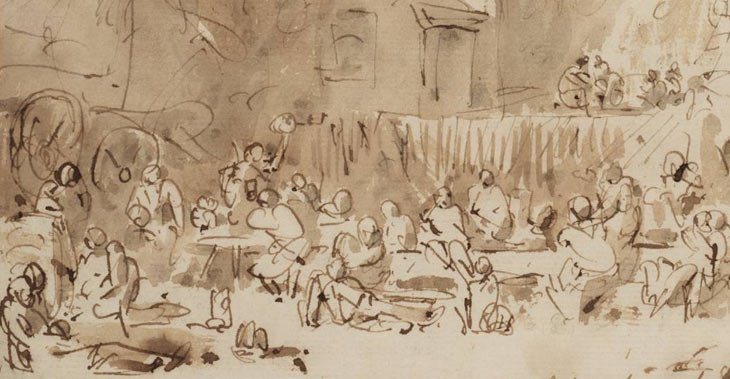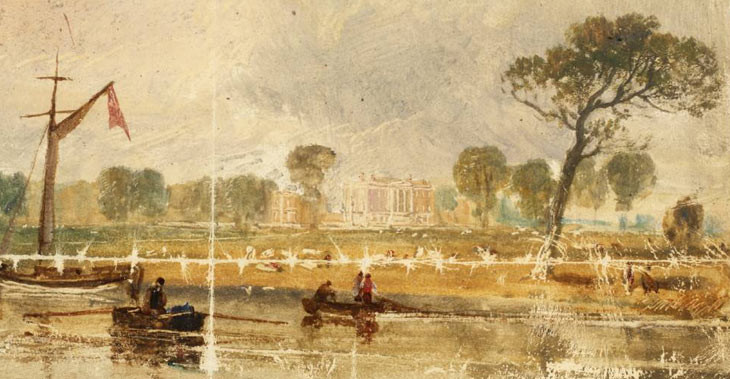Sketchbooks Connected with Work in Sussex, Yorkshire and Cumbria for the Earls of Egremont and Lonsdale 1809
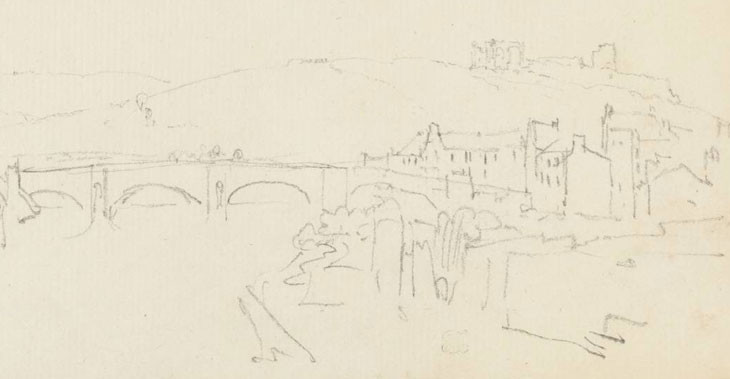
From the entry
In 1809 Turner was commissioned by the Earl of Egremont to paint his seats at Petworth, Sussex and Cockermouth Castle, Cumberland, and by the Earl of Lonsdale to paint Lowther Castle, near Penrith, Cumberland. That summer, Turner visited Sussex to draw Petworth and shortly afterwards set off for the North. Perhaps in August, he wrote from Cassiobury Park, the seat of the Earl of Essex near Watford, that he was thence ‘upon the wing toYorkshire for 2 months’. This was not strictly accurate as his main business lay west of the Pennines and perhaps he used ‘Yorkshire’ loosely as a generic expression for the North of England or, more likely, it was his first port of call. If so, the reason may have been to stay with Walter Fawkes at Farnley Hall in Wharfedale for the shooting, as he did for the first time in 1808 and almost annually from 1810 until Fawkes’s death in 1825. From there, he would have crossed the Pennines to Lowther to begin the serious business of his trip. Lord Egremont& ...
In 1809 Turner was commissioned by the Earl of Egremont to paint his seats at Petworth, Sussex and Cockermouth Castle, Cumberland, and by the Earl of Lonsdale to paint Lowther Castle, near Penrith, Cumberland. That summer, Turner visited Sussex to draw Petworth and shortly afterwards set off for the North. Perhaps in August, he wrote from Cassiobury Park, the seat of the Earl of Essex near Watford, that he was thence ‘upon the wing toYorkshire for 2 months’.1 This was not strictly accurate as his main business lay west of the Pennines and perhaps he used ‘Yorkshire’ loosely as a generic expression for the North of England or, more likely, it was his first port of call. If so, the reason may have been to stay with Walter Fawkes at Farnley Hall in Wharfedale for the shooting, as he did for the first time in 1808 and almost annually from 1810 until Fawkes’s death in 1825. From there, he would have crossed the Pennines to Lowther to begin the serious business of his trip.
Lord Egremont’s commissions for views of Petworth and Cockermouth, and the occurrence of views of both together with other subjects in Sussex, Cumbria and Lancashire in the now-dismembered Petworth sketchbook render it pointless to separate North and South in discussing of Turner’s touring in 1809. The Kirkstall Lock sketchbook, also now broken up, was variously used at Cassiobury, on the western outskirts of Leeds and at Whitehaven on the Cumbrian coast. Evidently, Turner used these larger roll sketchbooks throughout his trip, mainly for more finished drawings based on his day’s sketching. At the same time in Sussex, he used the smaller Frittlewell sketchbook for quick memoranda of scenery around Petworth while in the North he used the Lowther and Cockermouth sketchbooks, also smaller. He had another book, Sandycombe and Yorkshire, with him too which must thus be redated at least in part to 1809 (see below). He did not use the smaller books systematically; his choice of book and the sequence of subjects within often seem random, as if he simply pulled one from his pocket and found a blank page. Thus, the Lowther sketchbook contains sketches of Lowther Castle but other subjects in and around nearby Penrith are in the Cockermouth sketchbook, while Whitehaven subjects are spread between the Lowther and Cockermouth as well as the Kirkstall Lock sketchbooks and also exist in other collections, having perhaps originated in another sketchbook or books of the same date. Two drawings of Brougham Castle, near Penrith are in the Vale of Heathfield sketchbook otherwise devoted to Sussex and West Country subjects (see below).
The drawings and sketches Turner made in Sussex set the tone for his activities later that summer: a mix of work and play, collecting material for a commissioned picture but also taking time to explore nearby scenery and to fish; on-the-spot sketching and making the more careful drawings that have been described as ‘finished roughs’2 to be submitted for his patrons’ approval; and drafting passages of poetry and notes on historical or aesthetic matters that caught his interest. Of two alternative views of Petworth in the Petworth sketchbook, one of the house from the lake (D07515; Turner Bequest CIX 4) served as the basis for Petworth, Sussex, the Seat of the Earl of Egremont: Dewy Morning (Tate T03880; displayed at Petworth House).3 Quicker sketches of the park and scenery nearby were made in the Frittlewell sketchbook, the title given by Finberg deriving from a misreading of Turner’s inscription of the name of the Sussex village of Fittleworth.
Taken together, these sketchbooks give a much clearer picture of Turner’s activities in 1809, and especially of his tour in the North-West, than has emerged hitherto. Together with his letter from Cassiobury, they show that he did not go directly from London to Cockermouth as some scholars have thought,4 and throw further light on his work for Lord Lonsdale. A few subjects remain unidentified and there is still no firm evidence of Turner’s route from Yorkshire to Penrith. But from that point it becomes possible to reconstruct most of his itinerary and this writer was able to follow it in August 2009. Turner drew Penrith Castle and adjacent scenery in his Cockermouth sketchbook (D07546, D07548, D07549; Turner Bequest CX 8, 10, 11) and details of Lowther Castle in the Lowther sketchbook (D07892, D07893; Turner Bequest CXIII 25, 26); the latter also contains a glimpse of Askham Hall and the bridge over the River Lowther on the edge of the castle park (D07906; Turner Bequest CXIII 35a). Turner presumably stayed at Lowther, where Lord Lonsdale was hospitable to artists. Careful pencil or partly-coloured drawings of the castle and its park from a dismembered sketchbook and extant outside the Turner Bequest (Ashmolean Museum, Oxford and Fogg Art Museum, Cambridge, Massachusetts) indicate work over several days while scenery further afield around Penrith will have been sketched on rides or walks.
Having collected the material he needed for pictures of Lowther, Turner set off for Cockermouth. Here too he may have stayed at the castle where Lord Egremont had recently (1802–5) built a residential block inside the north walls, intending to spend July and August there. In the Cockermouth sketchbook, Turner drew the view northwards over the River Derwent ‘from Lord Egremonts room’ (D07562; Turner Bequest CX 22). It shows a fishing jetty built over the river from the private meadows and the Lowther sketchbook contains what might be its counterpart, a sketch of the Earl fishing from this very spot beneath the castle mound (D07941; Turner Bequest CXIII 56). Turner’s own love of fishing could be indulged here, and it may have been this year that the first bonds of friendship were forged between artist and patron. But Turner was hard at work during his visit too, drawing views of the castle from various angles. The Cockermouth sketchbook contains his first impressions while more carefully-worked drawings were made in the larger Petworth book. A view in the former (D07555; Turner Bequest CX 16) and a more finished version from the latter (D07536; Turner Bequest CIX 24) were used for Turner’s picture, Cockermouth Castle (Tate T03879; displayed at Petworth House).5
From Cockermouth, Turner went south-west to Whitehaven, pausing to sketch the remote Ennerdale in his Cockermouth book (D07566; Turner Bequest CX 25). Inside the front cover (D07537), he drew a rough map of places of interest in the area, including lakes and mountains, but his visit to Whitehaven must have been made with the prospect of further work for Lord Lonsdale, who ran the port and mining industry in the town. Also in this sketchbook, he drew Whitehaven Castle, the Lonsdale residence there (D07581; Turner Bequest CX 39). In the Lowther sketchbook, he made a quick double-page sketch of the harbour from the old quay (D07868–D07869; Turner Bequest CXIII 9a–10), while he used the larger Kirkstall Lock book for further drawings at Whitehaven and nearby Parton, then also a busy harbour. Whitehaven, like Lowther Castle, is the subject of careful and detailed drawings outside the Turner Bequest, including one of the famous ‘Hurries’, the gravity-loading system of rolling coal-chutes that supplied the colliers and was the showpiece of the Whitehaven docks (Yale Center for British Art, New Haven, Connecticut).
Turning south along the coast, Turner took out the Cockermouth book again to draw St Bees Head and the view of the distant Isle of Man (clearly, he was lucky with the weather). In the small town of St Bees he dew the old priory, then partly ruinous, and the bridge over Pow Beck (D07577; Turner Bequest CX 35). Turning inland again, his next stop was Egremont to draw the castle, another of Lord Egremont’s properties (D07567–D07571, D07578; Turner Bequest CX 26–30, 36). As at Cockermouth, he made some more careful drawings in his Petworth book (D07528, D07531, D07532; Turner Bequest CIX 16, 19, 20). Perhaps a picture of Egremont was mooted as a pendant for that of Cockermouth but rejected because, as Turner’s drawings show, the ruins are smaller and the setting less impressive.
In his Cockermouth book, Turner plotted a three-day itinerary to set him on his way back to London; ‘Tuesday E[gremont] Ulv[erston] | Wednesday Whitewell | Thursday Manchester’ (D07531; Turner Bequest CX 1). This schedule seems tight, and would have allowed little time for drawing. Perhaps he took longer. South of Egremont, he stopped to make sketches of Calder Abbey (D07572, D07573; Turner Bequest CX 31, 32) and a detailed and annotated one of Calder Bridge in the Cockermouth book (D07575; Turner Bequest CX 33); the latter was used for his picture Calder Bridge, Cumberland (private collection).6 Sketches of Millom Castle in the Sandycombe and Yorkshire sketchbook (see below) and more finished versions in the Petworth book (D07534, D07535; Turner Bequest CIX 22, 23) confirm that he took the coast road south, presumably to cross Duddon Sands to the Barrow Peninsular and Ulverston. Millom was another Lonsdale property, having been bought by the 1st Earl from the Huddleston family as a base for prospecting for iron ore. Turner would then have crossed Morecambe Bay to Lancaster, and taken the road though the Trough of Bowland to Whitewell. There, he probably stayed at the inn, and made at least three detailed drawings in his Petworth book (D07520, D07521, D07522; Turner Bequest CIX 8a, 9, 10). The time these must have taken, together with the attraction of fishing in the River Hodder behind the inn and the proximity of Browsholme Hall, the estate of his patron Thomas Lister Parker, might argue for a stay of more than one night. At Manchester, he presumably picked up the mail coach for London.
Additional Material:
Views of Millom Castle are in the Sandycombe and Yorkshire sketchbook (Tate D08975, D08976, D08978, D08998, D09001; Turner Bequest CXXVII 9, 9a, 11, 23a, 25a). Two drawings of Brougham Castle are in the Vale of Heathfield sketchbook (Tate D10314, D10315; Turner Bequest CXXXVII 70, 71). On this evidence, both books must be dated from 1809.
Acknowledgements:
The writer is grateful to The Dowager Lady Egremont for hospitality and to Mary Burkett, Pamela Woof, David Hill and Matthew Imms for their help and advice while researching this tour.
How to cite
David Blayney Brown, ‘Sketchbooks Connected with Work in Sussex, Yorkshire and Cumbria for the Earls of Egremont and Lonsdale 1809’, December 2009, in David Blayney Brown (ed.), J.M.W. Turner: Sketchbooks, Drawings and Watercolours, Tate Research Publication, December 2012, https://www


